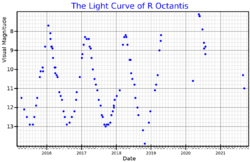Astronomy:R Octantis
| Observation data Epoch J2000.0 Equinox (celestial coordinates) | |
|---|---|
| Constellation | Octans |
| Right ascension | 05h 26m 06.19562s[2] |
| Declination | −86° 23′ 17.7741″[2] |
| Apparent magnitude (V) | 6.4 – 13.2[3] |
| Characteristics | |
| Spectral type | M5.5e[4] (M5.3e – M8.4e[3]) |
| Variable type | Mira[5] |
| Astrometry | |
| Radial velocity (Rv) | 46±5[6] km/s |
| Proper motion (μ) | RA: 0.540[2] mas/yr Dec.: 31.079[2] mas/yr |
| Parallax (π) | 1.7152 ± 0.0862[2] mas |
| Distance | 1,900 ± 100 ly (580 ± 30 pc) |
| Details | |
| Mass | 6.6[7] M☉ |
| Radius | 466[7] R☉ |
| Luminosity | 9,304[8] L☉ |
| Temperature | 2,571[8] K |
| Other designations | |
| Database references | |
| SIMBAD | data |
R Octantis, also known as HD 40857, is a solitary, red hued variable star located in the southern circumpolar constellation Octans. It has an apparent magnitude that varies in-between 6.4 and 13.2 within 405 days.[3] At is maximum, it is barely visible to the naked eye. The object is located relatively far at a distance of about 1,900 light years based on parallax measurements from Gaia DR3,[2] but is receding with a heliocentric radial velocity of 46 km/s.[6]
R Octantis has been known to have a peculiar spectra since 1892.[10] It was revealed to have emission lines in its spectrum in a 1954 paper[11] and was found to be a long period variable a year later.[12] In 1966, R Octantis was officially classified as a Mira variable.[4] Later observations reveal it to have an overabundance of oxygen on its outer layers.[13]
The object has an average stellar classification of M5.5e, indicating that it is a M-type star with emission lines in its spectrum.[4] However, this can range from M5.3 to M8.4e.[3] It is currently on the asymptotic giant branch, generating energy by fusing hydrogen and helium shells around an inert carbon core. As a result, it has expanded to 466 times the radius of the Sun.[7] R Octantis radiates over 9,000 times the luminosity of the Sun from its photosphere at an effective temperature of 2,571 K,[8] which is cooler than most Mira variables.
References
- ↑ "Download Data". AAVSO. https://www.aavso.org/data-download.
- ↑ 2.0 2.1 2.2 2.3 2.4 Vallenari, A. et al. (2022). "Gaia Data Release 3. Summary of the content and survey properties". Astronomy & Astrophysics. doi:10.1051/0004-6361/202243940 Gaia DR3 record for this source at VizieR.
- ↑ 3.0 3.1 3.2 3.3 Otero, Sebastian (26 April 2011). "R Octantis". AAVSO Website. American Association of Variable Star Observers. http://www.aavso.org/vsx/index.php?view=detail.top&oid=20343. Retrieved 21 April 2016.
- ↑ 4.0 4.1 4.2 Keenan, Philip C. (June 1966). "A Catalogue of Spectra of Mira Variables of Types ME and Se". The Astrophysical Journal Supplement Series 13: 333. doi:10.1086/190139. ISSN 0067-0049. Bibcode: 1966ApJS...13..333K.
- ↑ Samus’, N. N.; Kazarovets, E. V.; Durlevich, O. V.; Kireeva, N. N.; Pastukhova, E. N. (January 2017). "General catalogue of variable stars: Version GCVS 5.1". Astronomy Reports 61 (1): 80–88. doi:10.1134/S1063772917010085. ISSN 1063-7729. Bibcode: 2017ARep...61...80S.
- ↑ 6.0 6.1 Gontcharov, G. A. (November 2006). "Pulkovo Compilation of Radial Velocities for 35 495 Hipparcos stars in a common system". Astronomy Letters 32 (11): 759–771. doi:10.1134/S1063773706110065. ISSN 1063-7737. Bibcode: 2006AstL...32..759G.
- ↑ 7.0 7.1 7.2 Kervella, Pierre; Arenou, Frédéric; Thévenin, Frédéric (2022). "Stellar and substellar companions from Gaia EDR3". Astronomy & Astrophysics 657: A7. doi:10.1051/0004-6361/202142146. ISSN 0004-6361. Bibcode: 2022A&A...657A...7K.
- ↑ 8.0 8.1 8.2 McDonald, I.; Zijlstra, A. A.; Boyer, M. L. (2012). "Fundamental Parameters and Infrared Excesses of Hipparcos Stars". Monthly Notices of the Royal Astronomical Society 427 (1): 343–57. doi:10.1111/j.1365-2966.2012.21873.x. Bibcode: 2012MNRAS.427..343M.
- ↑ "V* R Oct". SIMBAD. Centre de données astronomiques de Strasbourg. http://simbad.u-strasbg.fr/simbad/sim-basic?Ident=V%2A+R+Oct.
- ↑ Fleming, M. (November 1892). "Stars having peculiar spectra". Astronomy and Astro-Physics 11: 765–767. Bibcode: 1892AstAp..11..765F.
- ↑ Bidelman, William P. (November 1954). "Catalogue and Bibliography of Emission-Line Stars of Types Later than B.". The Astrophysical Journal Supplement Series 1: 175. doi:10.1086/190007. ISSN 0067-0049. Bibcode: 1954ApJS....1..175B.
- ↑ Campbell, Leon (1955). Studies of Long Period Variables. American Association of Variable Star Observers. Bibcode: 1955slpv.book.....C.
- ↑ Jura, M.; Yamamoto, A.; Kleinmann, S. G. (August 1993). "Long-period oxygen-rich optical Miras in the solar neighborhood". The Astrophysical Journal 413: 298. doi:10.1086/172997. ISSN 0004-637X. Bibcode: 1993ApJ...413..298J.
 |


